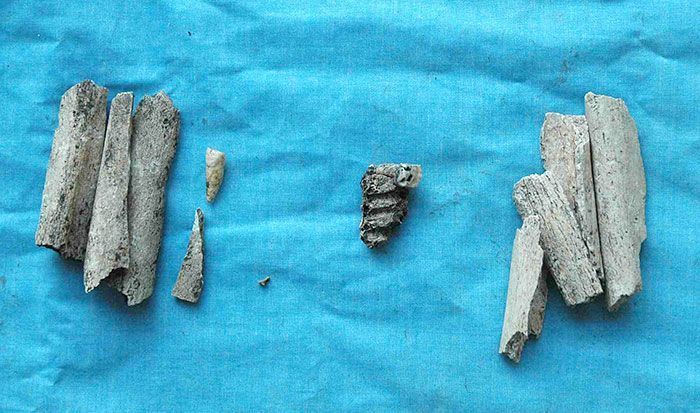Prehistoric Miyako people are a 100% DNA match with Jomon people, contrary to theory

Human bones unearthed during excavations around the Nagabaka burial site in Miyakojima City (July 2008)
November 12, 2021 Ryukyu Shimpo
The Max Planck Institute for the Science of Human History in Germany led 42 researchers from various countries such as South Korea, China, the United States, Japan including Okinawa, concluding before November 11 that the DNA (genome) of the prehistoric human bones unearthed around the Nagabaka burial site in Shimajiri Hirara, Miyakojima City, and those of the Jomon-era Japanese, were a 100% match. In the past, the prehistoric people of Miyako Island were believed to have come from the south, such as the Philippines and Taiwan. The result of this genome analysis establishes the possibility they may have come from the north, such as Okinawa Island. The study’s progression will be followed closely.
The paper titled “Triangulation supports the agricultural spread of the Transeurasian languages” was published in the British science journal Nature, and illustrates the migration routes of the Japanese, Ryukyuan, Korean, Mongolian languages.
Excavations at the Nagabaka burial site began in 2005, where prehistoric human bones and ornamental artifacts have been found. The genome of the unearthed human bones was analyzed and summarized in this paper.
The paper assumes that the farming techniques and language used by the prehistoric farmers who cultivated proso millet and foxtail millet in China’s West Liaohe region during the Neolithic period arrived in Okinawa through Korea and Kyushu. Co-author of the paper and Naha City-native, Professor Hiroto Takamiya, (Research Center for the Pacific Islands at Kagoshima University) said, “We illuminated the origins of the vernacular and people of the Ryukyus Islands and identified the agricultural transition period. It will be necessary to accumulate more data from the human bones, such as what grains were domesticated.”
Co-author Mitsugu Kugai of the Miyakojima City Board of Education said, “DNA analysis had never been conducted on the bones of prehistoric Miyako people before. Comparing that with the bones excavated from Japanese archaeological sites provides a novel and important perspective.”
(English translation by T&CT and Monica Shingaki)
Previous Article:Kin Town Council requests investigation and countermeasures pertaining to PFAS in tap water
Next Article:15-year-old Okinawan Shuri Araki wins third place overall at international standup paddle board competition, marking a breakout performance for the young competitor
[Similar Articles]
- Human bones dating back 9,000 years found at Sakitari Cave
- Amami’s oldest rock shelter tomb identified as 11-12th-century sakudamata, age determined by remains discovered there
- Okinawa Prefecture preserves the Shiraho-Saonetabaru Cave on the site of New Ishigaki Airport
- Bone of tall Jomon man found in Itoman City
- Genetic DNA of Okinawan people similar to people in the main islands of Japan
 Webcam(Kokusai Street)
Webcam(Kokusai Street)


